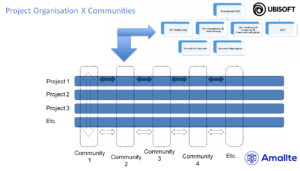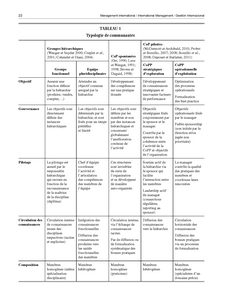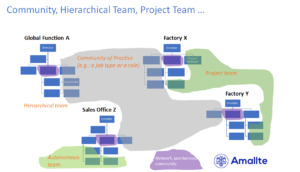The communities, a new model of organization?
In many companies, the trend is towards digital and network-based operation. Corporate social networks allow to create communities at the touch of a button. Managers replace the word “organization” with the word “community” in their communication (HR community, IT community…).
Starting from a short story, we will clarify what a community, a hierarchical team and a project team are. We will show an example of a company that has replaced its entire functional hierarchy with communities.
1. Communities are all over the place
Christine is HR manager of the marketing department of her company. The marketing director has decided to show that his management is a driving force in digital transformation and in new forms of collaborative work. He decided to replace the current organization by a community organization. Christine becomes both a community manager for project execution and a referent for the development of her team members. Communities are also created for marketing expertise, fields of activity (Web, TV…), and the leadership of the marketing department.

The marketing director can thus show the executive committee that digital transformation is a reality thanks to collaboration within the marketing “community”. Christine is confused. Who will be responsible if a project community is late or if the web community does not deliver the expected quality of service?
Some members of the Executive Committee are sceptical. They are familiar with well-functioning communities of practice related to the business lines, across the company, such as service purchasers or key account salespeople.
The Executive Committee asked HR to clarify the situation and appointed Christine as its head. A “community” working group is created. It engages a consultant specialized in corporate communities.
2. What is a community?
According to Jean-Philippe Bootz, professor and researcher at EM Strasbourg, head of the Knowledge Management Chair1,
Functional groups [hierarchical teams] are composed of homogeneous representatives sharing a disciplinary specialization. Their objective is to perform a function defined by the hierarchy. The method of recruitment is carried out by the line manager who controls the tasks of the members and ensures recruitment according to the recognition of the mastery of the discipline (diploma). The knowledge that circulates within these groups comes from the respective disciplines.
Multidisciplinary teams [project teams, autonomous teams, work groups] pursue a common objective assigned by the hierarchy (design a new product, implement a quality management system…). Being composed of heterogeneous representatives, the circulation of knowledge essentially refers to the ways in which teams integrate the various specific disciplinary knowledge. Members are recruited by the team leader and remain united by a common objective and requirements internal to the company. The team leader coordinates the activity and the articulation of the team members’ skills.
A community of practice brings together homogeneous members and has as its main objective the improvement of the activity through a reflection on the practice. It is characterized by its self-organized nature. Indeed, individuals participate in these communities, not because their hierarchy incites them to do so, but because this participation allows them to improve their competence in their field of activity.
3. The community, a transversal structure
Angélique’s working group meets in a workshop and, with the help of the consultant, reaches a consensus on the formal and informal structures in the company, as illustrated by the graph beside.
The mandate of the working group then shifts to supporting the communities, and only them.
The marketing director realizes that he has gone too far by calling any group of people a “community” and is rethinking another organization.
4. A matrix organization of communities X projects is possible
 In an organization that is mainly project-oriented, such as a consulting firm or software publisher, it is possible to replace the functional organization by communities.
In an organization that is mainly project-oriented, such as a consulting firm or software publisher, it is possible to replace the functional organization by communities.
Patrick Cohendet and Laurent Simon studied Ubisoft Canada2, a company that carried out this transformation in 2000 for its 6,000 employees. Each video game is a project. The communities of experts (game developers, sound engineers, programmers, etc.), open to the outside world, have replaced siloed organizations. The only remaining hierarchical organization is the corporate one with its statutory functions.
5. Action !
You want to:
- create or re-launch communities in your organization
- improve the use of your corporate social network (Yammer, Workplace…)
- improve cross-functional innovation or social learning with communities
- set up an Enterprise Community Program
- ensure the longevity of your knowledge management system (ISO 30401) through communities
Contact louis-pierre.guillaume@amallte.com
6. For more information
- « How to reconcile self-organization and control in driven communities of practice? : a scoping review » (article)
- “Playing across the playground: paradoxes of knowledge creation in the videogame firm” (article)
- « A community without a sponsor is dead! » (article)
- « Les communautés apprenantes dans les grandes organisations » (booklet of the CoP-1 Association)
- « Les communautés d’innovation » (book)
- « Communautés de pratique et management de la formation » (book)




Great post,It is characterized by its self-organized nature. Indeed, individuals participate in these communities.
I appreciated it when you shared that it is great to participate in communities so you are able to improve your competence in the field of activity. Besides, you can ensure that the people are well taken care of by the professionals. I would like to think if someone wants to help the people, he should consider joining a community organization.
Heya i am for the primary time here. I found this
board and I to find It really useful & it
helped me out much. I’m hoping to provide one thing back and help others like you helped me.
Pretty section of content. I just stumbled upon your website and in accession capital to
assert that I acquire in fact enjoyed account your blog posts.
Anyway I’ll be subscribing to your feeds and even I achievement you access consistently quickly.
Write more, thats all I have to say. Literally, it seems
as though you relied on the video to make your point.
You definitely know what youre talking about, why throw away your intelligence on just posting videos to your weblog when you could be giving us something informative to read?
Great goods from you, man. I have understand your stuff previous to and you’re just extremely great.
I really like what you’ve acquired here, certainly like
what you’re stating and the way in which you say it.
You make it entertaining and you still take care of to keep it smart.
I can’t wait to read much more from you. This is actually
a great website.
Its like you read my mind! You appear to know a lot about this, like
you wrote the book in it or something. I think that you could do with some
pics to drive the message home a bit, but instead
of that, this is magnificent blog. A great read. I’ll definitely be back.
I feel that is one of the most vital information for me.
And i’m glad reading your article. However want to observation on few basic things, The web site taste is great, the articles is in reality nice : D.
Excellent task, cheers
Thanks designed for sharing such a nice thought, piece of writing is
good, thats why i have read it completely
My partner and I stumbled over here different web page and thought I may
as well check things out. I like what I see so now i’m following you.
Look forward to checking out your web page again.
It’s very easy to find out any topic on net as compared to books, as I found this piece of writing at this web page.
I believe that is one of the such a lot vital information for me.
And i am satisfied reading your article. However wanna remark on some general issues, The website taste is perfect,
the articles is really nice : D. Excellent process, cheers
Wonderful article! This is the kind of info that
should be shared across the internet. Disgrace on Google for no longer
positioning this submit upper! Come on over and discuss with my
web site . Thanks =)